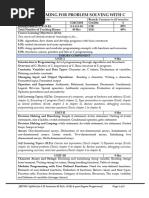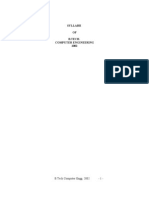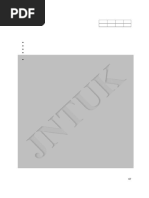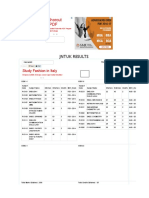0 ratings0% found this document useful (0 votes)
233 viewsProgramming For Problem Sloving
This document outlines the course objectives, outcomes, and content for the Programming for Problem Solving course. The course aims to teach students how to formulate solutions to problems using algorithms and flowcharts, develop basic C programs, and understand concepts like branching, iteration, arrays, pointers, and file handling. The course is divided into 6 units covering topics such as algorithms and flowcharts, the C programming language, control structures, modular programming with functions, arrays and strings, structures, and file handling. Students will learn how to develop algorithms and flowcharts, write basic C programs, implement control and iteration, work with functions, arrays and pointers, and handle files.
Uploaded by
Baswamy CseCopyright
© © All Rights Reserved
Available Formats
Download as DOCX, PDF, TXT or read online on Scribd
0 ratings0% found this document useful (0 votes)
233 viewsProgramming For Problem Sloving
This document outlines the course objectives, outcomes, and content for the Programming for Problem Solving course. The course aims to teach students how to formulate solutions to problems using algorithms and flowcharts, develop basic C programs, and understand concepts like branching, iteration, arrays, pointers, and file handling. The course is divided into 6 units covering topics such as algorithms and flowcharts, the C programming language, control structures, modular programming with functions, arrays and strings, structures, and file handling. Students will learn how to develop algorithms and flowcharts, write basic C programs, implement control and iteration, work with functions, arrays and pointers, and handle files.
Uploaded by
Baswamy CseCopyright
© © All Rights Reserved
Available Formats
Download as DOCX, PDF, TXT or read online on Scribd
You are on page 1/ 3
Subject Code Subject Name L T P C
CS- ES1105 Programming for Problem Solving 3 1 0 4
Course objectives:
Formulating solutions to problems using algorithms and flowcharts
Learning structure of C program, basic C programs, Compiling and executing C
Programs
Understand branching, iteration statements
Modular programming and recursive solution formulation.
Understanding arrays, pointers and dynamic memory allocation.
Comprehension of file handling and user defined data types.
Course Outcomes
1. Develop algorithms and flowcharts
2. Understand the compilation, debugging ,execution and writing of basic C programs
3. Develop C Programs using control and iterative statements
4. Develop C programs using functions
5. Apply the knowledge of arrays, strings and pointers in programming
6. Comprehend file handling and user defined data types
UNIT-I: Introduction to Computers ,Algorithm and Flowchart design through Raptor:
Introduction-Computer Hardware, Bits and Bytes, Components, types of languages.
Algorithm- Definition , Characteristics, Steps to develop ,examples.
Flow chart-Definition, symbols, Input/Output, Assignment, conditional if, repetition,
function and sub charts. Example problems– Finding maximum of 3 numbers, Unit
converters, Interest calculators, multiplication tables, GCD of 2 numbers, Fibonacci
generation, prime number generation. Minimum, Maximum and average of n numbers,
Linear search, Binary Search.
Learning outcomes: Student should be able to
1. Acquire the knowledge on basic computer components, algorithms and
flowcharts(L2)
2. Understand the structure of algorithm and flowchart(L2)
3. Develop basic flowcharts and algorithms for performing Input, Output and
Computations (L3)
4. Solve numerical problems using Raptor (L3)
UNIT-II:
Introduction to C Programming- structure of c program, Identifiers, The main () Function,
The printf () Function
Programming Style - Indentation, Comments, Data Types, Arithmetic Operations,
Expression Types, Variables and Declarations, Negation, Operator Precedence and
Associativity, Declaration Statements, Initialization. Compiling and Executing C program .
Assignment - Implicit Type Conversions, Explicit Type Conversions (Casts), Assignment
Variations, Mathematical Library Functions, Interactive Input, Formatted Output, Format
Modifiers.
Learning Outcomes: Student should be able to
Acquire the knowledge on fundamentals of c programming.(L2)
Analyze the structure of c programming (L4)
Develop basic sequential programs(L3)
UNIT -III:
Control Flow-Relational Expressions - Logical Operators:
Selection: if-else Statement, nested if, examples, Multi-way selection: switch, else-if,
examples.
Repetition: Basic Loop Structures, Pretest and Posttest Loops, Counter-Controlled and
Condition Controlled Loops, The while Statement, The for Statement, Nested Loops, The do-
while Statement.
Learning Outcomes: Student should be able to
Acquire the knowledge on control statements(L2)
Analyze the different programs using loops and conditional statements.(L4)
Implement programs using loops and branching statements.(L3)
UNIT-IV
Modular Programming: Function and Parameter Declarations, Returning a Value,
Functions with Empty Parameter Lists, Variable Scope, Variable Storage Class, Local
Variable Storage Classes, Global Variable Storage Classes, Pass by Reference, Passing
Addresses to a Function, Storing Addresses, Using Addresses, Declaring and Using Pointers,
Passing Addresses to a Function. Case Study: Swapping Values, Recursion - Mathematical
Recursion, Recursion versus Iteration.
Learning Outcomes: Student should be able to
Acquire the knowledge on functions.(L2)
Analyze the pre defined and user defined functions(L4)
Implement functions of their own to solve complex problem.(L3)
UNIT-V:
Arrays ,Strings & Pointers:
Arrays: One-Dimensional Arrays, Input and Output of Array Values, Array Initialization,
Arrays as Function Arguments, Two-Dimensional Arrays, Multi Dimensional Arrays-
Matrices
Strings: String Fundamentals, String Input and Output, String Processing, Library Functions
Pointers: Concept of a Pointer, Initialisation of pointer variables, pointers as function
arguments, passing by address, Dangling memory, address arithmetic, character pointers and
functions, pointers to pointers, Dynamic memory management functions, command line
arguments
Learning Outcomes: Student should be able to
Acquire the knowledge on arrays and strings.(L2)
Analyze the different types of arrays and string handling functions.(L4)
Implement string editing operations of their own to solve complex problem.(L3)
Acquire the basic knowledge on pointers.(L2)
UNIT-VI:
Structures, Files
Structures: Derived types, Structures declaration, Initialization of structures, accessing
structures, nested structures, arrays of structures, structures and functions, pointers to
structures, self referential structures, unions, typedef, bit-fields, enumeration.
Data Files: Declaring, Opening, and Closing File Streams, Reading from and Writing to Text
Files, Random File Access
Learning Outcomes: Student should be able to
Understand user defined data types(L2)
Analyze the differences between structure, union.(L4)
Implement different file handling programs using file handling functions.(L3)
Text Books:
1. Programming in ANSI C , McGrawHill, seventh edition by E.Balagurusamy.
2. The C programming Language, Dennis Richie and Brian Kernighan, Pearson
Education
3. ANSI C Programming, Gary J. Bronson, Cengage Learning.
Reference Books:
1. Programming in C, Bl Juneja Anita Seth, Cengage Learning.
2. C Programming-A Problem Solving Approach, Forouzan, Gilberg, Cengage.
3. Programming in C, Reema Thareja, OXFORD
4. C by Example, Noel Kalicharan, Cambridge
5. https://raptor.martincarlisle.com/
Download and Install Raptor software
Use the tool to draw flowcharts for the problems given.
COURSE OUTCOMES VS POs MAPPING (DETAILED; HIGH:3; MEDIUM:2;
LOW:1):
SNO PO PO PO PO PO PO PO PO PO PO PO PO12 PSO PSO PSO
1 2 3 4 5 6 7 8 9 10 11 1 2 3
C101 3 3 3 2 2 2 2 3 2 3
C102 3 3 3 2 1 1 2 3 1 3
C103 3 3 3 2 1 2 2 3 1 3
C104 3 3 3 2 1 3 1 3
C105 3 3 3 2 2 2 3 2 3
C106 3 3 3 2 2 2 2 3 2 3
C106* 3 3 3 2 1 2 2 2 3 2 3
You might also like
- BCA[Gen]_2nd Sem_Draft Syllabus 2023-25 (1)No ratings yetBCA[Gen]_2nd Sem_Draft Syllabus 2023-25 (1)25 pages
- Programming For Problem Solving Theory and LabNo ratings yetProgramming For Problem Solving Theory and Lab5 pages
- Detailed Syllabus (2023-24) of Programming for Problem Solving (K23ES11)No ratings yetDetailed Syllabus (2023-24) of Programming for Problem Solving (K23ES11)11 pages
- Bidyanagar, Mahura, Janla, Bhubaneswar - 752 054 (Orissa) : C.V.Raman College of EngineeringNo ratings yetBidyanagar, Mahura, Janla, Bhubaneswar - 752 054 (Orissa) : C.V.Raman College of Engineering5 pages
- B.Tech syllabus from 20.10.23 (1st Year) copyNo ratings yetB.Tech syllabus from 20.10.23 (1st Year) copy38 pages
- CSE1001 - Introduction To Problem Solving and ProgrammingNo ratings yetCSE1001 - Introduction To Problem Solving and Programming3 pages
- de_cuong_-_it1016-intro-cs-07042023_94.3kNo ratings yetde_cuong_-_it1016-intro-cs-07042023_94.3k5 pages
- C# Fundamentals Made Simple: A Practical Guide with ExamplesFrom EverandC# Fundamentals Made Simple: A Practical Guide with ExamplesNo ratings yet
- Fault Tolerant Systems Syllabus 14-05-2019No ratings yetFault Tolerant Systems Syllabus 14-05-20193 pages
- Information Technology: Academic Regulations Course Structure AND Detailed SyllabusNo ratings yetInformation Technology: Academic Regulations Course Structure AND Detailed Syllabus33 pages
- HDFC Bank Credit Card Customer Care Number - 24x70% (1)HDFC Bank Credit Card Customer Care Number - 24x75 pages
- CSVTU BE VII Semester IT Fault Tolerant Systems SyllabusNo ratings yetCSVTU BE VII Semester IT Fault Tolerant Systems Syllabus7 pages
- Project Category A B C D Organic Semidetached Embedded Table - 1No ratings yetProject Category A B C D Organic Semidetached Embedded Table - 11 page
- Lendi Institute of Engineering and Technology: Part BNo ratings yetLendi Institute of Engineering and Technology: Part B6 pages
- Two Tales of Privacy in Online Social NetworksNo ratings yetTwo Tales of Privacy in Online Social Networks4 pages
- Instant Access to Critical Thinking in Clinical Practice Improving the Quality of Judgments and Decisions Second Edition Eileen Gambrill ebook Full Chapters100% (1)Instant Access to Critical Thinking in Clinical Practice Improving the Quality of Judgments and Decisions Second Edition Eileen Gambrill ebook Full Chapters81 pages
- An Overview of Tribal Population in India: Tribal Health Bulletin, Special Issue 2014No ratings yetAn Overview of Tribal Population in India: Tribal Health Bulletin, Special Issue 2014131 pages
- Syncopating Rhythms Jazz Caribbean Culture100% (1)Syncopating Rhythms Jazz Caribbean Culture29 pages
- PDF Download For JEE Advanced Previous Year Questions With Solutions On GravitationNo ratings yetPDF Download For JEE Advanced Previous Year Questions With Solutions On Gravitation7 pages
- Hull OFOD10e MultipleChoice Questions Only Ch22No ratings yetHull OFOD10e MultipleChoice Questions Only Ch224 pages
- Akbar's Nauratan (Nine Jewels) : Abul FazalNo ratings yetAkbar's Nauratan (Nine Jewels) : Abul Fazal2 pages
- Kelompok 1 - Kelas H - Estimation of OGIP in A Water Drive Gas Reservoir Coupling Dynamic Material Balance and Fetkovich Aquifer ModelNo ratings yetKelompok 1 - Kelas H - Estimation of OGIP in A Water Drive Gas Reservoir Coupling Dynamic Material Balance and Fetkovich Aquifer Model11 pages
- Born From Darkness by Maryjessie PachecoNo ratings yetBorn From Darkness by Maryjessie Pacheco17 pages
- Civil Procedure Code and Limitation Law Final Draft - Srijita Kundan, Roll No. 133No ratings yetCivil Procedure Code and Limitation Law Final Draft - Srijita Kundan, Roll No. 13316 pages








































































































